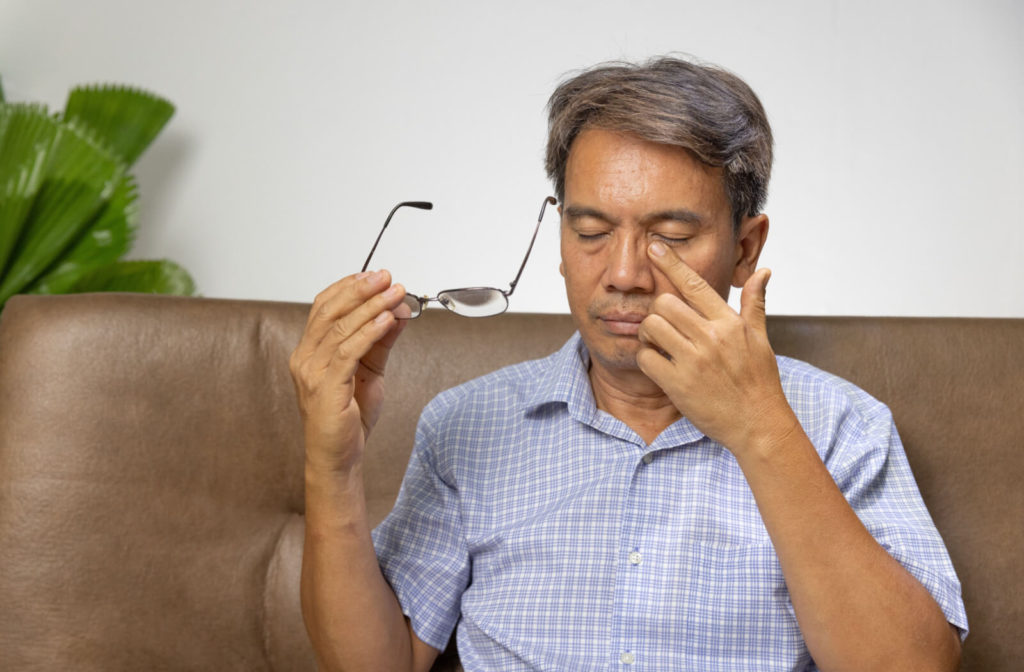If you have dry eyes, you may be looking for any solution to your symptoms. Thankfully, your eye doctor has several tools available to treat dry eyes and improve your quality of life.
There are many ways to relieve dry eyes, including artificial tears, prescription eye drops, lifestyle changes, eyelid hygiene, and in-office treatments.
You don’t have to live with dry eye symptoms—ask your optometrist which of these 6 remedies can help address your discomfort.
What is Dry Eye?
Dry eye is a condition where your tears cannot effectively lubricate the eye’s surface, leading to irritated, uncomfortable eyes. This condition can have many potential causes, making it difficult to determine what’s causing your irritation.
You may notice several symptoms if you experience dry eyes, including:
- Red eyes
- A stinging, burning sensation in the eyes
- Gritty eyes
- Watery eyes
What Causes Dry Eye?
Dry eye occurs due to problems in the tear film, 3 layers (mucus, water, and oil) that make up the tears spreading across the eyes every time you blink. When these layers experience issues, it can cause dry eyes.
Problems with the tear film can lead to 2 types of dry eye:
- Decreased tear production: Your body may not produce enough of the water component in your tears, making your eyes dry.
- Increased tear evaporation: If your meibomian glands, the glands surrounding your eyelids that produce oil for the tear film, become blocked or produce thick oils, your tears may evaporate too quickly and lead to dry eyes.
The most common cause of dry eye is meibomian gland dysfunction, a condition where these glands become blocked. Blockages in the glands prevent enough oil from stabilizing the tear film, causing dry eyes.
6 Remedies for Dry Eye
Dry eye is a complex condition with many possible causes, meaning there isn’t a straightforward fix for every patient.
When treating this condition, your eye doctor can carefully examine your eyes. Completing an eye exam can help them identify the cause of your irritation. They can then recommend ways to improve your symptoms.
Artificial Tears
Many lubricating eye drops are available without a prescription. These eye drops are known as artificial tears. They mimic your real tears to provide temporary moisture and protect your eyes.
Non-preservative artificial tears are always preferred. Many different variations are available with different components based on your type of dry eye.
Lifestyle Changes
Sometimes you don’t need treatment for dry eyes—you can improve your symptoms by adapting your lifestyle. Some habits or environmental conditions can affect dry eye development, like living in a dry climate or using digital devices for long periods.
You can try making some of the following lifestyle changes to improve your dry eye symptoms:
- Avoid smoke, wind, and circulating air
- Limit the amount of time you spend using digital devices
- Drink at least 8 to 10 glasses of water a day to stay hydrated
- Wear wraparound sunglasses to protect your eyes from wind and dust
- Use a humidifier to prevent a dry room
- Sleep for 7 to 8 hours every night
- Apply warm compresses for 15 minutes daily with a Bruder Mask
Prescription Eye Drops
Prescription eye drops differ from the artificial tears you can buy over the counter. They do more than provide moisture to the eye—prescription eye drops can address the root cause of dry eye symptoms. Your optometrist can recommend drops based on your needs after assessing your eyes during a comprehensive eye exam.
Two prescription eye drops your eye doctor may recommend include:
- Xiidra: Xiidra is an anti-inflammatory medication for dry eyes. Reducing inflammation in the eyes can help improve your tear film.
- Restasis: Restasis helps reduce inflammation that affects your tear production.
Intense Pulsed Light (IPL) Therapy
Intense pulsed light (IPL) therapy is an in-office treatment to improve dry eyes. Your optometrist uses a handheld device to apply pulsing light to the treatment area, heating the blood vessels in your eyelids
This treatment can reduce inflammation in the blood vessels to reduce dry eye symptoms. Additionally, it warms the meibomian glands, breaking down blockages which can improve oil flow to the tear film.
Radiofrequency Treatment
Radiofrequency treatment helps relieve dry eyes by applying energy to heat the eyelids. Like IPL, this heat warms the meibomian glands, removing blockages to improve oil flow.
Eyelid Hygiene
Your eyelid hygiene can factor into dry eye development. Dirt and debris can get trapped around the eyelids and eventually affect your tear film, creating inflammation and leading to dry eyes.
Your eye doctor can recommend several hygiene products, including eyelid wipes and scrubs.
Relieve Your Dry Eyes
Dry eyes can be irritating and uncomfortable, making daily life more difficult. However, you don’t need to worry about long-term discomfort—there are several ways to treat dry eyes with help from your eye doctor.
Our knowledgeable team at Discover Eyecare can recommend a customized treatment plan after determining the cause of your symptoms. Contact us today if you experience dry eye symptoms.



